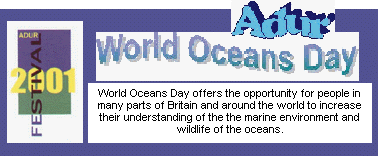30
June 2001
Sea
Watch Foundation Cetacean Workshop
Lancing
Manor Leisure Centre
Run
by Steve Savage (Regional
Co-ordinator)
This
is the first of three workshops (the second one is on 7
July 2001) on the identifications of cetaceans,
i.e.. whales and dolphins, including these sea mammals seen off the Sussex
coast.
This
first session will provide background to the work of Sea Watch and an introduction
to our work locally and how people can get involved.
Contact
via Adur DC is Natalie
Brahma-Pearl (Tel: 01273 263347)
Sea
Watch Foundation
Sussex
Dolphins web page
BMLSS
Cetaceans
28
June 2001
Shoreham
Beach Nature Reserve
There
will be meeting to discuss the future of the vegetated
shingle at Shoreham Beach, with experts from
English Nature, Adur District Council and West Sussex County Council. The
question of Nature Reserve status will be discussed.
The
meeting is at the Church of the Good Shepherd Hall and starts at
7:00 pm.
The idea
of the Shoreham Beach Nature Reserve received a mixed reception,
with the majority in support, many undecided and a few objectors.
27
June 2001
There
were two calling male
Quail heard from the path from Thundersbarrow
Hill (north of Southwick Hill) to Five Ways
last night, at around 9:30. There was also a possible calling female to
the north west of Lancing College on the same evening.
There
were no Quail calling late in the evening at Steepdown, north-west of Lancing
Clump (on the path to Cissbury Ring), but this is possibly an encouraging
sign of breeding as at least one male had been calling in the area for
two weeks.
Sussex
Ornithological Society Report
Report
by Dave Green
26
June 2001
The
scores of butterflies on Mill
Hill were Small
Heath Butterflies (pic)
and/or Meadow Browns
(pic).
These two species were flying strongly amongst the longer grasses
and I found it difficult to be 100% sure of their identification. They
always settled with their wings closed and at least one did not appear
to have a pair of eye-spots on the light brown upperside of their wings.
The Meadow Brown
is a much larger butterfly than the Small
Heath, so I think most of them were Meadow
Browns, although
I find size hard to judge with strong-flying insects.
The
first Greater Knapweed
begin to flower. (pic).
Butterflies
(Bioimages)
25
June 2001
Clean
Air Talk by Adur District Council (Tim Bartlett & Natalie Brahma-Pearl)
at the Tarmount Studios 7:00 pm
Messages
on Adur Air Quality
Pyramidal
Orchids could be seen on the Old
Shoreham to Beeding cycleway, but only an occasional Red
Admiral butterfly and not much to see in the heat at 24°
C. The towpath on the west side was overgrown and nearly impassable by
bicycle.
24
June 2001
A
very small garden pond (TQ 219 063) in The Drive, Shoreham-by-Sea,
(near Buckingham Park) was visited by a male Blue-tailed
Damselfly (the male identified by its
blue head and thorax), Ischnura
elegans, and a small white moth,
possibly a common species, fluttered
amongst the waterside plants. Froglets
crawled over the lily pads, where one
lily was in flower, but most of the
frog tadpoles
were
still black with only one pair of rear legs in many cases. The tadpoles
develop much more slowly in crowded garden ponds and many fail to develop
at all before the winter.
21
June 2001
The
weather remained sunny if not particularly warm at 22° C for the Summer
Solstice, and at night Mars
shined brightly to the south before midnight, and looked silver-pinkish
through the binoculars in the clear Moonless sky. No detail could be seen
in low-powered 10 x 25 binoculars.
18
June 2001
A small shoal of juvenile
first year Pollack, Pollachius pollachius,
came as a great surprise to me on a mussel collecting
expedition at Kingston beach. In well over a
thousand observations I have never seen shoals of these fry before. The
mid-water shoals are usually Sand Smelt Atherina presbyter; Bass,
Dicentrarchus
labrax; or Grey Mullet, Chelon labrosus. Pollack shoals are
are a characteristic of Cornish and Devon estuaries. At first the back
of the tiny fish up to 40 mm long looked a coppery colour so I suspected
a Pouting,
Trisopterus
luscus, but even in the postlarvae the more streamlined nature of the
Pollack was clear, but if any doubt was needed the marked gaps between
the three dorsal fins was decisive. The fish also lacked the barbel of
the Pouting. Out of sunlight the back looks more greenish-brown. The shoal
numbered about 200, maybe more, as my view was obscured. Thousands of Sea
Gooseberries shared the same sea as the juvenile Pollack.
Dogwhelks,
Nucella
lapillus, have just returned to this shore after an absence from 1982.
They are all old specimens and even 20 years I do not recall any eggs.
With a covering of mud, one Dogwhelk could be mistaken for a Common Whelk,
Buccinum
undatum, especially as its size at 52 mm is bigger than average. Dogwhelks
usually average about 20 mm to 30 mm, and specimens can reach 60 mm. On
Kingston
beach, they still need looking for, and are rarely below 35 mm in length.
The woolly caterpillar of
the Garden Tiger Moth, Arctia caja,
crawled over the tarpaulin in the basket of my Pashley delivery bicycle
in the front garden of my home in Corbyn Crescent, east of central Shoreham.
17
June 2001
Over
McIntyres field near Lancing Ring,
House
Martins, Swallows and Swifts dissect the air with
precision flying as they collect airborne food on the wing. Over farm buildings
at Sompting and at the nearby Open Space near St Mary's Close all three
species were seen in spectacular form as they darted around buildings and
over hedgerows. (TQ 156 052)
16 June
2001
A black
wild Rabbit was reported the population
of bunnies at Lancing Down, Sussex (TQ 180 062). This is not thought to
be an escaped domestic rabbit, but a colour strain present in the wild
population and reported occasionally from all parts of Britain.
Report
by Veronica Eltringham (FOLR)
14 June
2001
 The
shingle
beach at Shoreham beach along to the Widewater
is a colourful sight with Red Valerian
(red and white) , Viper's Bugloss
(blue), Sea Thrift (pink),
Sea
Kale (white), Tree
Mallow (crimson, not so much as usual),
Yellow-horned
Poppy,
Silver
Ragwort and a few garden flowers particularly
colourful as expected during the best month of June. A party of school
children, pencils and pads in their hand were on a field trip near the
Church of the Good Shepherd.
The
shingle
beach at Shoreham beach along to the Widewater
is a colourful sight with Red Valerian
(red and white) , Viper's Bugloss
(blue), Sea Thrift (pink),
Sea
Kale (white), Tree
Mallow (crimson, not so much as usual),
Yellow-horned
Poppy,
Silver
Ragwort and a few garden flowers particularly
colourful as expected during the best month of June. A party of school
children, pencils and pads in their hand were on a field trip near the
Church of the Good Shepherd.
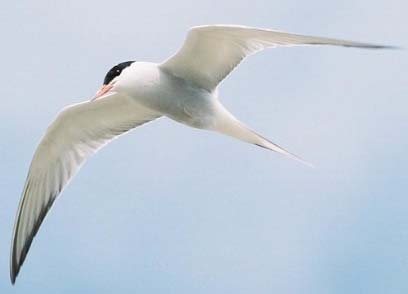 11
June 2001
11
June 2001
Offshore
from Brooklands Boating Lake, Common Terns,
with their distinctive forked tails, swept low over the sea that was showing
the first signs of white horses, and descended to take a feed from just
below the surface in one swift swoop. Black-headed Gulls, in breeding
livery with a completely dark (brown) head, were attempting the same manoeuvre
without the same elegance. A half dozen Cormorants congregated around
the post marking the outlet pipe, occasionally diving under. This is a
regular flocking area for these fish eating birds with frequently up to
29 birds that can be quickly counted.
Sea
Birds Portfolio (Photographs by Nicolas Jouault)
The
Ringed
Plover reveals itself by its swift running
over the shingle. Without moving it is too well camouflaged and difficult
to spot. The summer residents birds and much plumper than the lean winter
visitors. As the tide ebbs and the water recedes,
more (a half dozen in 50 metres of sand) of these small birds appear on
the emerging sand flats.
 Under
the sea, Paul Parsons
returned from a brief foray with a handful of very small Actinothoe
sea anemones, a small sea hare Elysia
viridis, and some other very small
orange anemones with whitish orange tentacles. After close study I can
confirm that these are the often overlooked Diadumene
cincta. The mouth is orange in some specimens, but the most
useful diagnostic difference from the similar Plumose
Anemones is their instant jerky reaction when touched.
Under
the sea, Paul Parsons
returned from a brief foray with a handful of very small Actinothoe
sea anemones, a small sea hare Elysia
viridis, and some other very small
orange anemones with whitish orange tentacles. After close study I can
confirm that these are the often overlooked Diadumene
cincta. The mouth is orange in some specimens, but the most
useful diagnostic difference from the similar Plumose
Anemones is their instant jerky reaction when touched.
Under
Worthing Pier (Page 3)
Sea
Anemones (Link)
 10
June 2001
10
June 2001
Thousands
of Common Spotted Orchids are in flower on the chalk bank of westbound
A27 Shoreham bypass near Slonk Hill (TQ 225 065).
A
Quail
was calling to the East of Steep Down, behind Lancing.
The
bird can be heard calling from the bridleway which runs from Lancing
Clump to the Bostal Road, and passes to the east of Steep Down. There
is no chance of seeing the bird here as it is on private land 30 metres
below the path, but it was calling at 5:00 for at least 30 minutes around
250 metres to the south of the pylons. This area is also very good for
Skylark,
Meadow Pipit, Corn Bunting, Yellowhammer, Linnet etc.
Sussex
Ornithological Society Report
Report
by Dave Green
5 June
2001
I
made a brief visit to the Waterworks Road. There was nothing much there
apart from the millions of stinging nettles. But I was surprised to see
a Moorhen in the narrow stream, surprised because of the vicinity
of the Vixen and her cubs (see
below).
On
a sunny Mill Hill, above the 45° Sycamore
incline from the Waterworks, butterflies
fluttered around, rarely remaining still for more than a brief few seconds,
because the largest and commonest (12 +) were the restless Wall Browns,
and a single solitary Small Heath Butterfly, the single eye
spot clearly distinct on the underside from the orange. There were small
orange butterflies fluttered in the grasses and these could be Skippers.
A female Common Blue
settled. Lastly, a single a
Dingy Skipper was definitely identified,
although the the white dotted band on the topside of the front wings were
much more distinct than shown in my book.
Butterflies
(Bioimages)

Prawns
This
is rather an ordinary observation but the two species of prawns
found on Kingston Beach are showing remarkable
differences. The smaller Palaemon elegans in the higher pools have
dark blue, almost black, markings and egg masses, whilst the larger Paleamon
serratus at the low tide mark are remarkably reddish with orange egg
masses. This colour guide cannot be relied upon as the larger prawns can
be blue and both species almost transparent with hardly any clear lines.
Both species of prawns had been eating green algae.
7 June
2001

An
Animal
Rights letter was sent to the Shoreham Herald complaining about the
Lobsters
in the tubs at Adur World Oceans Day.
Reply
(Link)
5 June
2001
Many
birds in song on the downs approaching Southwick
Hill from the north or west, including Corn
Buntings (15), Yellowhammers,
Skylarks,
and nearer the hill Meadow Pipit and
Whitethroat (10).
Sussex
Ornithological Society Report
Report
by Dave Green
| 4
June 2001 to 15 June 2001 weekdays
|
3 June
2001
A
Fox,
a vixen with 3 cubs
was seen from a distance of 200 metres on the Waterworks Road, on the flood
plain below Mill Hill. Footpaths lead down
to this private road from the top of the Street in Old Shoreham and from
the bridge over the flyover leading to Mill Hill, but these paths are narrow
and overgrown.
Walking
on wooded land close to the base of Mill Hill
near the River Adur, we saw what appeared to be
a large black to iridescent dark blue butterfly.
It seemed to be larger than a Painted Lady for example. It flew in
a slow fluttering movement and was about 60 cm (2 ft) from the ground as
we saw it. I could not follow its path. A local resident confirmed that
it had been seen previously.
Experienced
lepidopterists have pointed out that it is most likely to be a Beautiful Demoiselle,
Calopteryx
virgo, a damselfly. The Sussex
branch of the Butterfly
Conservation Society confirmed that Beautiful
Demoiselle damselflies had been confirmed breeding on the bird reserve
near the Waterworks on the Adur flood plain, just north of Old Shoreham.
UK
Dragonflies Discussion Group
Lancing
Nature & History - June 2001 Newsletter
Adur
Flood Plain report of the Demoiselle with photograph
2
June 2001
A
pair of Mute Swans with six furry cygnets greeted the workers
setting up at the stalls for Adur World Oceans Day, but as the neap
tide ebbed they had disappeared before the start of the event.
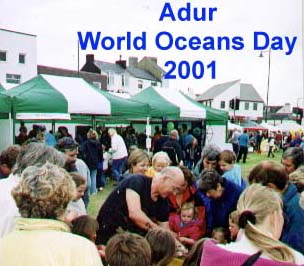
The
day was overcast with brief periods of sun through gaps in the clouds and
short periods of torrential rain that sent people diving for cover in the
marquee. |
29
May 2001
A
Speckled
Wood Butterfly
landed in my Lancing garden (TQ 186 045).
29
May 2001
A
pair of Mute Swans with five furry cygnets were in Shoreham
Harbour, in the canal section east of the lock gates, together with
thousands of Moon Jellyfish.
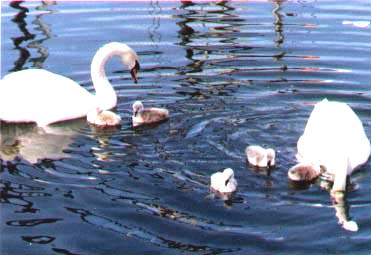
26
May 2001
The
Fox
that
lives around the large beach houses near Old Fort, Shoreham
Beach has the mange. Apparently this can be treated with drugged food
and a kit is provided by Fox Watch.
Report
by David Wood
Previous
Report
25
May 2001
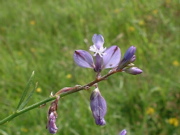 Mill
Hill was covered by vast expanses of yellow on the green grasses,
of Buttercups and
Horseshoe Vetch,
with Daises and
patches of blue with the Milkwort
and
Speedwell,
Veronica
sp., as well as small seemingly stunted versions
of orchids.
Mill
Hill was covered by vast expanses of yellow on the green grasses,
of Buttercups and
Horseshoe Vetch,
with Daises and
patches of blue with the Milkwort
and
Speedwell,
Veronica
sp., as well as small seemingly stunted versions
of orchids.
Butterflies
A
few restless brown butterflies danced in
the light breeze. At least some of the larger ones were Wall
Browns, distinctive because of the black-ringed white eye-spot on the
opened highly patterned wings (different from a Tortoiseshell). There were
smaller brownish butterflies, they were restless and these were Small
Heath Butterflies (TQ 212 071). These butterflies
are easy to misidentify when the similar but larger Meadow Browns are around.
The food plant of the caterpillars of the Small Heath are various grasses.
Meadow
Brown Butterflies have not reported from elsewhere this early in 2001.
Notes.
The Grizzled
Skipper Butterfly was exceptionally attractive
when it landed on a buttercup (TQ 212 072).
In
Shoreham
town especially near the allotments and
Sea Kale
on the beach, scores of Small ? White Butterflies
fluttered as expected. About 10% of these had a yellowy tinge.
UK-LEPS
Discussion Group (for Butterflies and Moths)
UK-Botany
Discussion Group
Adur
Valley Butterflies
UK
Wildlife Discussion Group
Shoreham
Beach
Butterfly
Conservation Society
Butterfly
Guide
24
May 2001
A
large (slightly larger than a goose egg) greenish speckled egg rolled down
Ham Road outside the Morning Star Public House. I suspect that this was
broken egg belonged to one of two pairs of Herring
Gulls reported as trying to breed on the
the large flat roof of the nearby Adur Civic Centre.
Report
by Andy Horton with the breeding information from
Tim
UK
Birding Discussion Forum
24
May 2001
The
sea
off Sussex and probably all along the eastern English Channel is exceptionally
clouded with plankton forming long strings in places. This is the species
Phaeocystis
pouchetti known colloquially as
Slobweed and other names.
British
Marine Life Study Society News 2001
23
May 2001
A
particularly beautiful damselfly
caught my eye as it settled on Southwick beach promenade wall next to the
timber yard. It had a particularly brilliant metallic emerald green head
and thorax and an elegant metallic light blue abdomen. There did not seem
to be any distinctive markings on the delicate wings. It may be a female
Ischnura
elegans known as the Blue-tailed
Damselfly. However
this identification is not confirmed.
UK
Dragonflies Discussion Group
21
May 2001
The
ctenophore (comb-jelly) Sea Gooseberry,
Pleuribrachia
pileus, is both ubiquitous and superabundant pelagically in the NE
Atlantic Ocean, but on the low springs (0.4 metre) at Kingston
beach in the early evening was only the second time that I have actually
discovered this animal that appears as transparent globules in the prawn
net. In a miniature aquarium, the two long
tentacles tangle underneath and the swimming combs of this tiny ovoid predator
appear to shimmer. At night it is phosphorescent.
Marine
Wildlife of the North-east Atlantic Ocean Group
20
May 2001
For
my first sighting this year of Orange Tip
Butterfly but had to go to Sussex
Wildlife Trust HQ at Woods Mill, Small Dole, Sussex.
 18
May 2001
18
May 2001
Taking
advantage of the newly re-opened cycleway
from Old Shoreham to Beeding, the adjacent towpath was covered in a fine
mat of grass. A Kingfisher
flew straight as a dart with something large and white in its beak, and
a Peacock Butterfly settled
on the grasses, notable as my personal first note of this butterfly
on these notes. Other butterflies
fluttered amongst the nettles.
In
the field opposite the Cement Works, on the western side of the Adur
including the towpath, both cows
and sheep grazed.
18
May 2001
The
footpaths to Lancing Ring
are now open.
West
Sussex County Council announce most paths are now open, unless they are
inhabited or used by farm livestock, or farm animals are nearby. At first
it would seem that virtually every single path north of Shoreham
is adjacent to fields that will contain livestock at least at some time
during the year, both on the Downs or in the Adur
Valley, and the restrictions may still apply.
The
cycle
path from Old Shoreham to Bramber has
already started to be used.
|
Most Public Paths
NOW OPEN
Unless a path displays this notice (red with white writing):
|
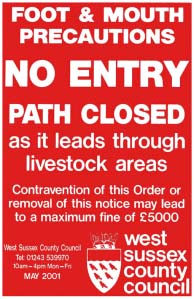
|
You
are welcome to use any public path if you:
Stay
on the path and leave gates exactly as you find them.
Respect
red "no entry" notices.
Donít
go near sheep, cows, goats, pigs, or deer.
Donít
go into any field if you canít easily avoid those animals. |
|
If
you do come across them walk slowly away, retracing your steps if necessary.
Donít
leave waste food or litter anywhere and donít feed ANY animal.
Keep
dogs on short leads at all times and off all land where livestock are present.
Use
disinfectant where provided.
Clean
your boots after each walk. |
|
17
May 2001
It
appears this year there has been an increase in the numbers of Chaffinches,
Robins
and
Song
Thrushes at the expense of Starlings,
which are still abundant. A Great Tit
in St. Mary's churchyard, Shoreham,  was
seen in the strong breezy (Force 6) afternoon. This bird is reported to
be one of the commonest garden birds in Cornwall, but I have never found
it to be particularly common In Shoreham.
was
seen in the strong breezy (Force 6) afternoon. This bird is reported to
be one of the commonest garden birds in Cornwall, but I have never found
it to be particularly common In Shoreham.
Beaufort
Scale (sea)
Beaufort
Scale (land)
16
May 2001
A
juvenile Owl was found on the ground close to the nursery in Lancing
Manor Park. It was picked up and put back in a nearby tree by the Adur
Watch patrol.
Report
by Tim Clarke
15 May
2001
 It
is astonishing the rapidity the Dogwhelks
(a gastropod mollusc)
have colonised the relatively new rock sea defences on Southwick beach
(TQ 240 046) near the lock gates. Hundreds in mostly white and dirty grey
colours, but orange ones and purple ones also, but there were no signs
of striped specimens.
It
is astonishing the rapidity the Dogwhelks
(a gastropod mollusc)
have colonised the relatively new rock sea defences on Southwick beach
(TQ 240 046) near the lock gates. Hundreds in mostly white and dirty grey
colours, but orange ones and purple ones also, but there were no signs
of striped specimens.
Most
of the Beadlet Anemones were reddish-brown
and I saw none of the 'strawberry' variety.
13
May 2001
A
Pond
Skater flew into a garden in The Drive, Shoreham (TQ 219 063).
It was walking on the surface of the small pond, hardly, a remarkable event,
and it was probably the commonest species Gerris lacustris.
Hemiptera
Checklist
UK
True Bugs Discussion Group
11
May 2001
Lancing
Manor allotments hosted two Linnets,
both birds with the distinctive red throat of the male. Under a tin sheet
there were two Grass
Snakes and four Slow
Worms.
A
quick look at St
James' churchyard, Lancing, saw Speckled
Wood, Peacock
and Holly Blue butterflies.
At home in Lancing a Comma
basked on a warm wall briefly.
Butterflies
of Lancing
11
May 2001
Hot
and humid briefly, up to 21° C with the first butterflies
on the wing in Shoreham, including a Small
White Butterfly near the footbridge and
a Holly Blue Butterfly
fluttered rapidly across the Eastern Avenue railway crossing gates and
another one fluttered in the Community Centre grounds in Pond Road, Shoreham.
9 May
2001
A
pair of House
Martins are nesting in Gordon Road, Shoreham-by-Sea
as they did last year.
Two
relatively fine but windy days come to an abrupt end with a thunderstorm
with continuous flashes of lightning and some very heavy rain in the late
evening up to and past midnight. The claps of thunder were loud enough
to prevent any chance of sleep.
8 May
2001
I
saw my first red butterfly
(species unidentified) of the year over the shingle on the sea side of
Widewater, but attention was simultaneously distracted by a female
Kestrel overhead, from underneath the
pale blue with streaks stood out from the blue sky of the first fine and
sunny day of the year. The female looks much larger than a male and could
be mistaken for a Sparrowhawk. This bird glided and than paused for the
familiar hover, before swooping off on the wind. It is usually the
male that is blue underneath.
There
was a meeting between the Environmental Agency, with contractors, Halcrow,
and the Friends of Widewater Lagoon over the sea defences planned for the
shingle between the lagoon and the sea, and the ecological impact on Widewater.
The transcript is on the following site (click on the text):
FOWL
7 May
2001
Foot
& Mouth Restrictions still in force in the Adur Valley
Footpaths
in the lower Adur Valley are still all closed. As far as I am aware, not
a single path has been reopened In West Sussex, so the downs
and Adur Valley are still a no go area for the May Bank Holiday Monday.
1 May
2001
For
summer is a comin' in
And
winter is a gone - o.
A
merry May to you.
The
first day of May was greeted by a cold east wind and continuous heavy rain.
27
April 2001
The
first Moon Jellyfish appear
in Shoreham harbour.
26
April 2001
A Holly
Blue Butterfly
flutters quickly across a Lancing garden. (TQ 185 046).
23
April 2001
The
elongate small fish known as the Butterfish,
because of its slippery nature, or Gunnel (misspelling of gunwhale), Pholis
gunnellus, were present on Kingston beach
on the low spring tide.
22
April 2001
A
count of 340 Bar-tailed Godwits and 81 Gannets plus other
birds flew past Southwick beach.
Sussex
Ornithological Society News up to 22 April

15
April 2001
I
received a report via the RSPCA of three young sharks washed up on the
beach at either Lancing or Worthing. A size was not mentioned. I assume
these are Lesser-spotted Dogfish, Scyliorhinus
canicula, which are so commonly washed ashore dead in all months of
the year that they scarcely warrant a special mention. The specimen above
was discovered intact near the Old Fort a couple of months ago, before
it had been spotted by the gulls that scavenge along the strandline.
9 April
2001
Ray
Hamblett
reports Common
Lizards, Lacerata
vivipara, (confirmed
ID) and
Slow
Worms,
Anguis
fragilis, near the remounts of flint walls
and grassland near Widewater.
Widewater is a brackish lagoon, but there are pools that are probably near
fresh water and dry out in the summer months. These small amphibians and
reptiles occasionally become the prey of visiting Kestrels.
Photographs
(Link to web page)
3 April
2001
A
pleasant sunny day with Meadow
Pipits seen from the river towpath by
the
airport, with a splash of white on the underside
of their tail and calling as they leave their perches, including the Sea
Purslane at low tide on the Adur
estuary. These
may be Rock
Pipits or Water
Pipits.
Cuckoo's
Corner on the Coombes Road has begun to be landscaped, but this has
halted because of Food & Mouth Disease restrictions. A Robin
darted amongst the underbush taking advantage of the dislodged invertebrates.
By
early evening it is was overcast and raining again, which continued with
heavy continuous rain and moderate near gales (> Force 7) for the rest
of the week.
The
Frog
Tadpoles hatch in a north Shoreham garden.
The spawn was first laid in the middle of February.
2 April
2001
Adur
Quality of Life

'Our
Shared Vision' the Adur District Council's
Agenda 21 Sustainable Development Document
is published.
The
publication was written and designed by Natalie Brahma-Pearl.
2 April
2001
 In
St
James-the-Less churchyard, Lancing, (TQ183 056) I spotted Small
Tortoiseshell Butterflies maybe two. Also
two Comma Butterflies
basking
close to emerging nettle patch and a Peacock
Butterfly landing on a tombstone.
In
St
James-the-Less churchyard, Lancing, (TQ183 056) I spotted Small
Tortoiseshell Butterflies maybe two. Also
two Comma Butterflies
basking
close to emerging nettle patch and a Peacock
Butterfly landing on a tombstone.
Birds
including a warbler with a sharp trill voice and rounded tail with chestnut
colour tail feathers, and Blue, Great & Long-tailed Tits.
It
was the warmest (16° C) sunniest day of the rain, but by late afternoon
it had started raining again.



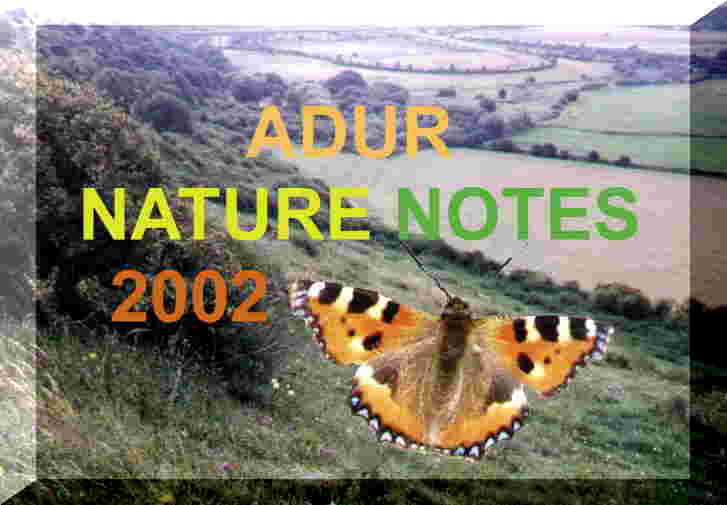
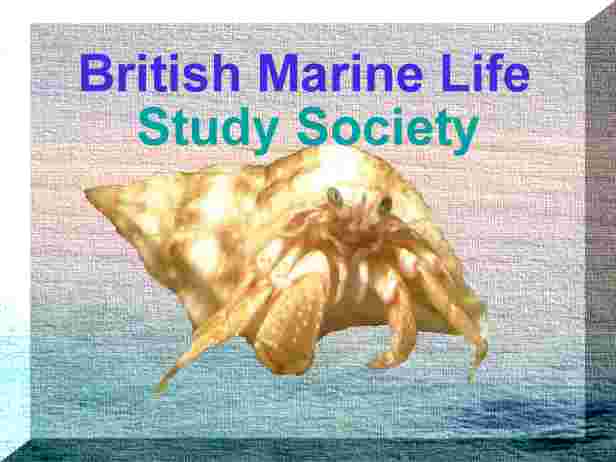






 BIODIVERSITY
DISPLAY
BIODIVERSITY
DISPLAY

